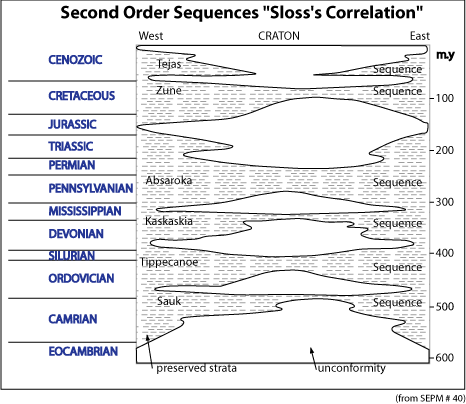So, you have actually observed the formation of the fossils in the fossil record? And you saw that a slow and gradual–“plain old ordinary”–deposition of sediments on bones successfully fossilized them?
So, you have come across a “whale falls” study, where the bones were not consumed by bacteria in ocean sediments, over a few years’ time? If so, please give me the link to it.
And why do you think this?
Actually, they are only explainable by the dynamics of the biblical Flood. For example, the evolutionary model calls for a super slow rise in ocean levels–one source said, “.01/week.” Now think about that a minute… The Sauk megasequence alone deposited 3 million cubic kilometers of ocean sediments across North America. Do you, in all reality, believe that ocean waters rising at an imperceptible rate of .01 inch/week would have the hydrodynamics to pick up such a load of sediments and spread them out in layers (according to Walther’s Law) across 75% of North America?
In fact, the Tonto Group of sedimentary rock layers in the Grand Canyon are 1135 feet thick. And this group was deposited by the Sauk transgression. Would ocean waters rising at .01 in/week have the hydrodynamic power to have first picked up, then deposited, this load of sediment?
In fact, notice the distinct layering of these sedimentary rock layers, in accordance with Walther’s Law that calls for a “thinning up” of sediments in a transgressive flow: Muav LIMESTONE…on top of Bright Angel SHALE…on top of Tapeats SANDSTONE.
Yes, there are “vast numbers of layers”–of varying thicknesses. This is why sequence stratigraphy speaks of different “orders” of sequences. A first order sequence is the longest, down to 5th (and possibly even smaller) order sequences.
Such smaller, more frequent layers are what would be predicted by the numerous “pulses” of tsunami-like waves of the Flood. Scripture alludes to plate tectonics as a factor in the flooding as it describes seafloor rifting–rifting that would lead to seafloor spreading (contributing to the flooding of continents)…which would lead to ocean plates subducting beneath continental plates…which would not only produce numerous volcanoes (like the 452 volcanoes along the Pacific coast, called “the Ring of Fire”)…but would also set off numerous tsunamis–another product of subduction zones. And, there are over 30,000 miles of such zones…that’s a lot of tsunamis…which would explain the hydrodynamic power that transported the sediments. At least it would come much closer than “.01 inch/week”!
The Great Unconformity erosion zone–which includes even large boulders–can certainly be explained by the Sauk transgression. Such a transgression picked up, transported, and deposited 3 million cubic miles of ocean sediments across 75% of North America. So, it was plenty powerful enough to erode the basement granite, resulting in the Great Unconformity!
But I will tell you what definitely did not have the hydrodynamic power to erode basement granite–namely, ocean waters rising to flood the continent at .01 inch/week!
